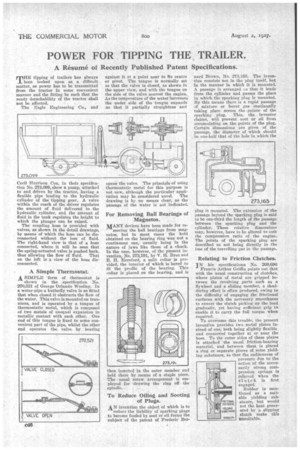POWER FOR TIPPING THE TRAILER.
Page 68

If you've noticed an error in this article please click here to report it so we can fix it.
A Résumé of Recently Published Patent Specifications.
pYIE tipping of trailers has always been looked upon as a difficult matter, as power has to be transmitted from the tractor in some convenient manner and the fitting be such that the ready detachability of the tractor shall not be affected.
The Eagle Engineering Co., and
Cecil Harrison Cox, in their specification No. 273,099, show a pump, attached to and driven by the tractor, having a flexible pipe leading to the hydraulic cylinder of the tipping gear. A valve within the reach of the driver regulates the amount of fluid delivered to the hydraulic cylinder, and the amount of fluid in the tank regulates the height to which the plunger can be raised.
The coupling hose is provided with valves, as shown In the detail drawings, by means" of which the hose can be disconnected without the loss of fluid. The right-hand view is that of a hose connected, where it will be seen that the spring-actuated valve is pushed back, thus allowing the flow of fluid. That on the left is a view of the hose disconnected.
A Simple Thermostat. A SIMPLE 'form of thermostat is
shown in the specification No. 270,521 of George Orlando Woolley. In a water-pipe a butterfly valve is so fitted that when closed it obstructs the flow of the water. This valve is mounted on trunnions, and is operated by a tongue of thermostatic metal, which is composed of two metals of unequal expansion in metallic contact with each other. One end of this tongue is fixed to some convenient part of the pipe, whilst the other end operates the valve by bearing against it at a point near to its centre or pivot. The tongue is normally set so that the valve is closed, as shown in the upper view, and with the tongue on the side of the valve nearest the engine. As the temperature of the water increases the under side of the tongue expands so that it partially straightens and opens the valve. The principle of using thermostatic metal for this purpose is not new, although the particular application may be considered novel. The drawing is by no means clear, as the passage of the water is not indicated.
For Removing Ball Bearings of Magnetos.
MANY devices have been made for re
moving the ball bearings from magnetos, but in most cases the hold obtained on the bearing ring was not a continuous one, usually being in the nature of jaws like those of a chuck. In the Case, however, of the present invention, No. 273,191, by V. II. Bran and E. H. Hereford, a split collar is provided, the interior of which is bored to fit the profile of the bearing. This eellar is placed on the bearing, and is then inserted in the outer member and held there by means of a staple piece. The usual screw arrangement is employed for drawing the ring off the spindle.
To Reduce Oiling and Sooting of Plugs.
AN invention the object of which is to reduce the liability of sparking plugs to become fouled by soot or oil forms the subject of the patent of Frederic Ber
nard Brown, No. 273,16:3. The invention consists not in the plug itself, but In the manner in which it is mounted. A passage is arranged to that it leads from the cylinder and passes the place in which the sparking plug is mounted. By this means there is a rapid passage uf mixtore or burnt gas continually taking place across the points of the sparking plug. This, the inventor claims, will prevent soot Pr oil from accumulating on the points of the plug. Certain dimensions are given of the passage, the diameter of which should be one-half that of the hole in which the
plug is mounted. The extension of the passage beyond the sparking plug is said to be one-third the length of the passage between the sparking plug and the cylinder. These relative dimensions may, however, have to be altered to suit the compression ratio of the engine. The points of the sparking plug are described as not being directly in the hue of the travelling gas in the passage.
Relating to Friction Clutches.
IN his specificationn No. 209,696
Francis Arthur Griffin points out that with the usual construction of clutches, where plates of metal are gripped between the revolving parts such as a flywheel and a sliding member, a shuddering effect is often produced, owing to the difficulty of engaging the frictional surfaces with the necessary smoothness to ensure the clutch picking up the load gradually, yet having sufficient grip to enable it to carry the full torque when required. .
To overcome this trouble, the present invention provides two metalplates instead of one, both being slightly flexible and connected together at or near the boss. To the outer sides of these plates is attached the usual friction-bearing material, and between them is placed a ring or separate pieces of some yielding substance, n that the suddenness of pressure due to the action of the necessarily strong compression springs is relieved, when the clutch is first engaged.
Rubber is mentioned as a suitable yielding substance, but would not the heat generated by a slipping clutch make this unsuitable.












































































































